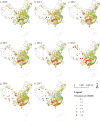Spatio-temporal distribution of tuberculosis and the effects of environmental factors in China
- PMID: 35733132
- PMCID: PMC9215012
- DOI: 10.1186/s12879-022-07539-4
Spatio-temporal distribution of tuberculosis and the effects of environmental factors in China
Abstract
Background: Although the World Health Organization reports that the incidence of tuberculosis in China is decreasing every year, the burden of tuberculosis in China is still very heavy. Understanding the spatial and temporal distribution pattern of tuberculosis in China and its influencing environmental factors will provide effective reference for the prevention and treatment of tuberculosis.
Methods: Data of TB incidence from 2010 to 2017 were collected. Time series and global spatial autocorrelation were used to analyze the temporal and spatial distribution pattern of tuberculosis incidence in China, Geodetector and Geographically Weighted Regression model were used to analyze the environmental factors affecting the TB incidence.
Results: In addition to 2007 and 2008, the TB incidence decreased in general. TB has a strong spatial aggregation. Cities in Northwest China have been showing a trend of high-value aggregation. In recent years, the center of gravity of high-value aggregation area in South China has moved further south. Temperature, humidity, precipitation, PM10, PM2.5, O3, NO2 and SO2 have impacts on TB incidence, and in different regions, the environmental factors show regional differences.
Conclusions: Residents should pay more attention to the risk of developing TB caused by climate change and air pollutant exposure. Increased efforts should be placed on areas with high-value clustering in future public resource configurations.
Keywords: Environmental factors; GWR; Geodetector; Spatio-temporal distribution; Tuberculosis.
© 2022. The Author(s).
Conflict of interest statement
The authors declare that they have no competing interests.
Figures






References
MeSH terms
Grants and funding
LinkOut - more resources
Full Text Sources
Medical

